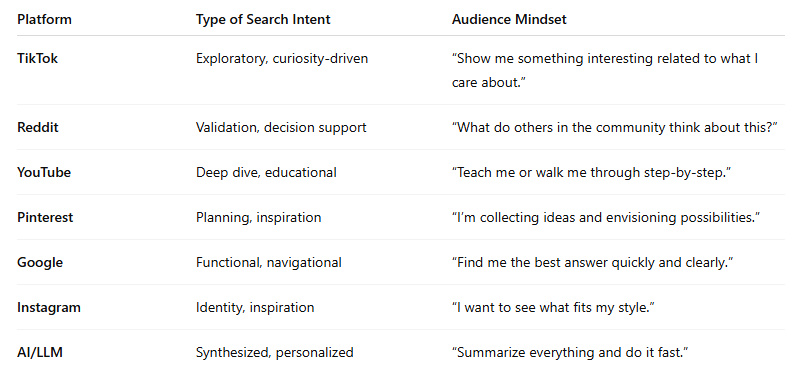
Adobe announces integration of Photoshop, Express, and Acrobat features into ChatGPT

LinkedIn launches new features to improve ad personalization

AI Overviews by Google Changed Search Almost Overnight

5 minutes
Not every platform deserves your presence. The most successful brands meet audience intent with clear purpose, the right context, and platform-specific creativity.
Recently, the phrase “search everywhere” has become popular in marketing strategies, presentations, and team meetings. It sounds like a call to action and a vision of a brand that’s present everywhere.
But here’s the problem — many companies interpret it as “be everywhere, for everyone.” The result is scattered content across all channels, attempting to reach every audience but delivering diluted messages, weak ROI, and the exhausting feeling of playing endless digital whack-a-mole.
In reality, “search everywhere” isn’t about showing up everywhere. It’s about being where your audience already is — and meeting their search intent.
Once, search was almost synonymous with Google. Gradually, YouTube joined the picture, and SEO specialists focused on ranking in SERPs, optimizing content, and competing for “rich snippets.”
Today, the landscape is different:
The epicenter of SEO hasn’t disappeared — it has democratized. Search intent now lives across various formats, communities, and algorithms. The “search everywhere” strategy is built on recognizing search as a behavior, not just a platform.
Some brands mistakenly think that the “search everywhere” approach means “publish everywhere and wait for results.” But the effective method is to focus only on the channels where the audience is already actively searching, exploring, or planning.
Steps to build this strategy:
Montirex — a dynamic UK fashion brand — has a strong presence on TikTok. This enables them to actively participate in the “festival outfits” conversation, building both recognition and preference among their audience.
At the same time, Pinterest — highly popular among this target group — is underutilized by the brand. This presents a clear opportunity to grow where users are already planning their looks and seeking inspiration.
Understanding that search happens across different platforms is only the first step.
The second is accepting that your brand doesn’t need to be present on all of them.
A true search everywhere strategy acknowledges that each platform has its own search intent logic, unique user behaviors, and distinct content expectations.
If your goal is not just presence but preference in your audience’s mind, you must meet those expectations.
People search very differently on TikTok, Reddit, YouTube, Pinterest, Google, Instagram, or through AI/LLM tools. Their mood, information needs, and content consumption formats shift from platform to platform. If your content doesn’t reflect that, it won’t get found — it’ll simply be ignored.

Each of these platforms is already a search engine — but they reward different behaviors and process content in different ways. Simply posting the same material everywhere without adapting its format, tone, or value isn’t search everywhere; it’s just mechanical duplication.
Let’s say we have the query: “festival outfits for men 2025”.
The flawed “be everywhere” approach would look like this:
The result: the content is everywhere, but nowhere at full strength — because it lacks platform-specific creativity.
The true search everywhere approach could look like this:
This isn’t just cross-posting — it’s platform-oriented content creation that reflects the specific search moment.
Search everywhere has never meant “be everywhere, for everyone.” It’s about intentional presence — showing up where the conversation happens, where the brand is relevant (or can become relevant), and where the audience is already searching.
This is not a semantic nuance — it’s a strategic approach:
Search in 2025 is visual, vocal, conversational, and community-driven — not just text queries in Google. And with the rise of LLMs, brand visibility can be shaped from any corner of the internet.
So next time you hear “search everywhere”, ask yourself:
If the answers are negative — you’re not executing search everywhere, you’re just adding noise.
In 2025, search is no longer a purely “Google” process. It happens within an ecosystem of dozens of platforms — each with its own logic of intent, formats, and value signals.
The biggest mistake brands make is trying to be “everywhere” without adaptation. This not only wastes resources but also dilutes brand recognition.
For a search everywhere strategy to work, you need to:
Search everywhere is about focus and alignment, not chaotic presence. When a brand appears in the right moment and in the right format, it doesn’t just get views — it builds trust and influence.
This article available in Ukrainian.
Say hello to us!
A leading global agency in Clutch's top-15, we've been mastering the digital space since 2004. With 9000+ projects delivered in 65 countries, our expertise is unparalleled.
Let's conquer challenges together!
performance_marketing_engineers/
performance_marketing_engineers/
performance_marketing_engineers/
performance_marketing_engineers/
performance_marketing_engineers/
performance_marketing_engineers/
performance_marketing_engineers/
performance_marketing_engineers/